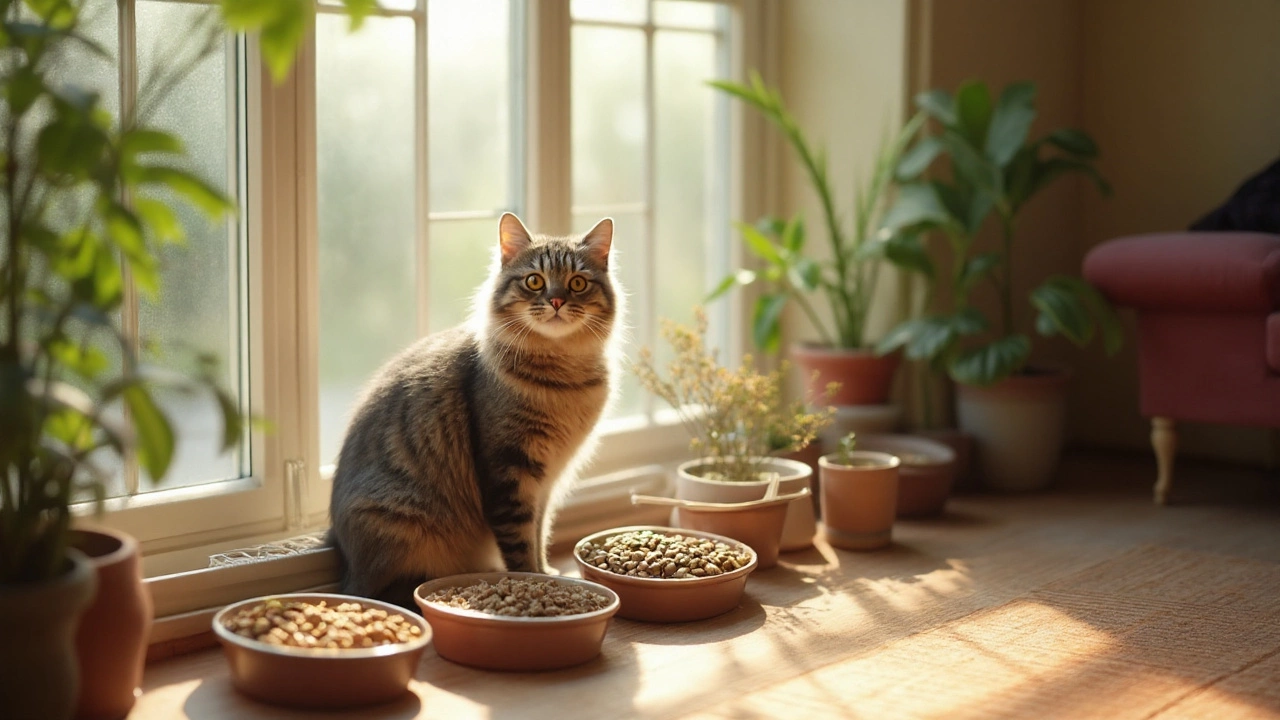Ever looked at your cat basking in a patch of sunlight and wondered what’s really inside that bowl of kibble you keep refilling? Your living room tiger might act like a ruthless hunter, but when it comes to diet, she’s got very specific needs you can’t just guess at. Most people figure any supermarket cat chow is good enough, but if you peek behind the flashy packaging, you’ll find there’s a ton more to think about. The wrong meal can pile on pounds, trigger tummy trouble, and even mess with that famous silky fur. And let’s be honest: is any sound sadder than a cat meowing for dinner with those big, hungry eyes?
Understanding a House Cat’s Unique Nutritional Needs
Your average house cat shares 95% of her DNA with lions and tigers, but her metabolism’s got a pace all its own. House cats are obligate carnivores, which means they absolutely must get animal-based protein to thrive. Unlike dogs—or humans—they can’t live on veggies or even grains. Their bodies crave amino acids like taurine, arginine, and methionine. Sure, these might sound like “mad scientist” ingredients, but they’re non-negotiable if you want your cat’s heart, eyes, and immune system running smoothly.
Fat gets a bad rap for humans, but for cats, it’s essential. Fats provide concentrated energy and help them absorb vitamins such as A, D, E, and K. While you might battle with weight gain, cats actually need moderate, high-quality fat sources to keep their coats shinier than a luxury car. And don’t forget water—cats typically don’t drink a lot, so their food needs to offer moisture, or they’ll be prone to urinary issues. That helps explain why so many indoor cats visit the vet each year for bladder problems.
Vitamins and minerals matter too, but it’s easy to overdo supplements if you’re not careful. Vitamin A, for instance, must come from animal sources. Plant-based A (like what’s in carrots) does nothing for cats. And while you’ll see flashy multi-vitamins online, trusted brands balance these micronutrients by formula. If you’re making food at home, that gets tricky fast.
Here’s a quick rundown of cat nutrient basics:
| Nutrient | Main Role | Sources |
|---|---|---|
| Protein | Build muscles, fuel growth | Chicken, turkey, fish, beef |
| Fat | Energy, healthy skin/coat | Salmon oil, chicken fat, eggs |
| Taurine | Heart & eye function | Animal tissues |
| Arginine | Waste removal | Meat, fish |
| Vitamin A | Vision, immune function | Liver, animal fat |
| Water | Urinary health, digestion | Wet food, fresh water |
All this means the best cat food isn’t just about taste or price. It’s about whether it lines up with what your little predator’s body is begging for—animal protein, clean fat, and the right vitamin mix from animal ingredients.

Wet vs Dry Food: The Debate and What Really Matters
Now for the kitchen showdown that stirs up more debate than pineapple on pizza: wet food or dry? Each side has its fans, and each comes with real trade-offs. Dry food, or kibble, is super convenient and doesn’t spoil quickly, which means you can leave it out for grazers. It’s less messy, cheaper per serving, and supposedly helps scrape tartar off those sharp teeth. But here’s the catch: most dry food is loaded with carbs, which cats have no need for. If there’s corn, wheat, or soy in those crunchy bits, your cat’s just burning calories her ancestors never ate in the wild.
Wet food, on the other hand, packs the plate with moisture—usually over 75%, compared to 10% in kibble. That makes it gentler on kidneys and helps prevent urinary tract problems that plague indoor cats (think litter box woes and costly vet trips). Because wet food is closer to the texture and protein levels of prey, most cats go crazy for it. Plus, since it’s dense with meat, your feline gets full sooner, limiting overeating.
But wet food’s got its downsides, too. It costs more, you have to refrigerate leftovers, and it can stink up your kitchen fast. Some picky cats will snub a flavor after one whiff, leaving you stuck with cans they won’t touch. You also have to clean bowls more often to avoid bacteria buildup—cats are like gourmet food critics: presentation matters.
So what’s the answer? Actually, many vets suggest mixing it up. A portion of wet food in the morning to get water and protein, then a small amount of dry for snacks or “grazing” later. That way your cat gets the benefits of both, and you can ease off the guilt if you’re running out the door without popping a fresh can open each time.
Quick tip: Always check the ingredients list. You want whole meat (not “meat by-products” or “animal digest”) listed first. Skip fillers and too many unpronounceable additives when you can. Some premium brands, like Tiki Cat, Wellness, and Orijen, get top marks for their protein quality and transparency. Don’t be fooled by clever marketing—just because there’s a photo of salmon on the can doesn’t mean salmon is in there.
Here’s how typical wet and dry foods stack up in terms of composition:
| Wet Food | Dry Food | |
|---|---|---|
| Protein (%) | 10-12 (as fed) ~40-50 (dry matter) | 30-40 |
| Fat (%) | 5-8 (as fed) | 10-20 |
| Carbs (%) | 1-5 | 25-50 |
| Moisture (%) | 75-85 | 8-12 |
Balance matters more than extremes. Some cats need help shedding pounds (so go easy on dry food), others need support fighting off kidney trouble (wet food wins there). Watch your cat’s litter box and energy levels; they’ll often tell you what’s working better than even the fanciest test results.

Tailoring Cat Food for Special Health Needs, Preferences, and Life Stages
Cats aren’t one-size-fits-all, so the best cat food depends on age, health, and personal quirks. Let’s start at the beginning. Kittens grow at lightning speed; they’ll burn through calories like a marathon runner. Always go for food formulated for “growth” or “kitten” on the label—they have more protein and essential nutrients for healthy bones, brains, and that kitten chaos energy. Trying to feed a kitten adult food can stunt their growth or cause deficiency issues.
Adults can stay on a high-quality “all life stages” diet with a focus on premium animal proteins and balanced fat. Watch for signs of overfeeding—indoor cats aren’t chasing birds like their ancestors, so those calories can pile on. Cat obesity has doubled in the past decade, with some surveys showing up to 60% of house cats overweight. Not cute when it means diabetes, arthritis, or heart trouble down the road.
Senior cats (age 7 and up) need a gentler balance. As cats age, their kidneys become pickier about excess phosphorus and sodium, so look for senior formulas with moderate protein but fewer minerals, or ask your vet for kidney-supporting options. If your cat’s teeth are wearing down or missing, wet or mousse foods help avoid gum pain and under-eating. Appetite often dips in older cats; strong-smelling, high-quality meaty foods can get them eating again.
Some cats struggle with food allergies or sensitivities. You’ll know the drill if you notice lots of scratching, bald patches, or stubborn vomiting. Limited ingredient diets using a single protein (like rabbit or duck) work wonders in these cases. For cats with diabetes or weight issues, low-carb, high-protein formulas are best—often more like grain-free wet foods.
Let’s bust a myth: Grain-free dry foods are not always healthier. They often swap in starchy peas or potatoes for corn, which can still boost carbs high enough to mess with blood sugar and gut health. Always check actual carbohydrate levels, not just marketing tags.
Don’t ignore picky eaters, either. You might need to trial several foods (give each a fair shot, at least three days) and serve at room temperature for more tempting smells. Some cats love variety, so switching up flavors is fine as long as the nutritional base stays solid. Avoid “free-feeding” bowls unless your cat self-regulates well; measured, scheduled meals help maintain a waistline and alert you if your cat’s appetite suddenly drops—a fast red flag for illness.
Here are a few more tips for different household setups:
- Multiple cats? Feed separately if possible—bullies can scarf extra food and leave timid eaters underfed.
- Rescue/adopted cats: Slowly transition to a new diet over at least a week. Mix a bit of the old food with the new, increasing the new blend each day to reduce upset stomachs.
- Supplements: Only use under a vet’s advice. Too much vitamin D or calcium can hurt, not help.
- Popular homemade diets, like raw food: These can work but require expert balancing—most home recipes miss key nutrients unless you use professional-grade supplements and recipes tested by board-certified veterinary nutritionists.
Your cat’s food shouldn’t just keep her alive. When it hits the right balance, you’ll spot it: sparkling eyes, silky fur, playful sprints through the hallway, and that low, happy purr while she chows down. Don’t fall for fads—a sound meal plan grows a healthy, happy house cat year after year. And hey, you get all the snuggles, head bumps, and silly zoomies that make life with cats the best kind of wild.

